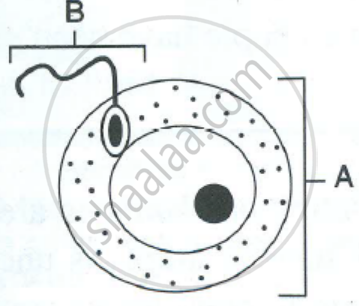Advertisements
Advertisements
Question
In male and female reproductive system of human, ______ gland is same.
Solution
No answer.
There is no similar gland in the male and female reproductive systems. While there may be some homologies, there are no similarities.
APPEARS IN
RELATED QUESTIONS
Explain the process of birth in human beings.
If a woman is using a copper-T, will it help in protecting her from sexually transmitted diseases?
The diagram shown below is the longitudinal section of a testis of man. Study it carefully and answer the questions that follow

(i) Label the parts numbered 1 to 3 in the diagram.
(ii) In which part of the testis are the sperms produced?
(iii) State the functions of the parts labelled 1 and 3 in the diagram.
Name the cells that secrete Testosterone
State the exact location of the Proximal convoluted tubule.
Differentiate between Sperm duct and fallopian rube (function)
Given below are diagrams showing the different stages in the process of fertilisation of an egg. in the human female reproductive tract.
Study the diagrams and answer the questions:
1) Arrange the letters given below each diagram in a logical sequence to show the correct order in the process of fertilisation.
2) Where does fertilisation normally take place? and What is ‘Implantation’ that follows fertilisation?
3) Mention the chromosome number of the egg and zygote in humans.
4) Explain the term ‘Gestation’. How long does Gestation last in humans?
5) Draw a neat, labelled diagram of a mature human sperm.
State whether human beings reproduce by sexual method or asexual method.
Do all organisms give birth to individuals like humans?
What are the organs in humans which produce the gametes?
Write the names of female sex hormones.
What is gestation period? How much is the gestation period in humans?
What changes are seen in boys at the time of puberty?
Draw a labelled diagram of the human male reproductive system. With the help of this diagram, describe the working of human male reproductive system?
Where does fertilisation take place in human females?
What is placenta? What is its function?
What joins embryo to placenta in mother's body?
In a flower, the parts that produce male and female gametes are respectively :
(a) sepal and anther
(b) filament and stigma
(c) anther and ovary
(d) stamen and style
During adolescence, several changes occur in the human body. Mark one change from the following associated with sexual maturation in boys.
The ratio of the number of chromosomes in a human zygote and a human sperm is ______
The diagram below represents two reproductive cells A and B. Study the same and then answer the questions that follow:
 |
- Identify the reproductive cells A and B.
- Name the specific part of the reproductive system where the above cells are produced.
- Where in the female reproductive system do these cells unite?
- Name the main hormones secreted by the (1) ovary (2) testes.
- Name an accessory gland found in the male reproductive system and state the function of its secretion.
Describe the role of the following in human beings:
(i) Seminal vesicles
(ii) Prostate gland
Choose the correct answer:
Binary fission is a method of __________
Name the following:
Two accessory glands in the male reproductive system.
Name the following:
Organ where implantation takes place.
Answer the following question.
What is contraception? List three advantages of adopting contraceptive measures.
What are the signs of puberty in human males and females?
Differentiate
Urinogenital system and Urinary system.
Name the Following
What does this abbreviation stand for IUD?
Mention, if the following statement is True or False. If false rewrite the wrong statement in its correct form:
Women after the age of 45 years normally cannot produce children.
Choose the Odd One Out:
The mature sperms are stored in the ____________.
Mention the importance of the position of the testes in humans.
What is the composition of semen?
The membranous cover of the ovum at ovulation is ______.
A zygote is formed by the fusion of a male gamete and a female gamete. The number of chromosomes in the zygote of a human is ______.
